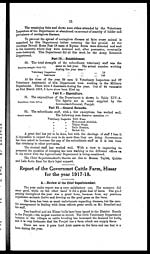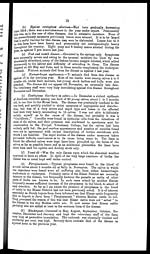Medicine - Veterinary > Civil Veterinary Departments > 1894-1932 - Annual report of the Punjab Veterinary College and of the Civil Veterinary Department, Punjab > 1909-1919 > 1917-1918 - Annual report on the Punjab Veterinary College, Civil Veterinary Department, Punjab, and the Government cattle farm, Hissar, for the year 1917-18
(430) Page 12
Download files
Individual page:
Thumbnail gallery: Grid view | List view

12
I inspected the farm three times during the year, and also supervised
the selection of bulls for the districts and selected young male stock to be put
aside for bulls to be issued to District Boards during the coming year. After
his 18 years' experience of the farm the Chief Superintendent considers that
Mr. Branford deserves great credit for his management of the Farm.
B.—Report by Mr. R. Branford, Superintendent, Cattle Farm, Hissar.
1. The farm was under my charge for the whole of the year except
during July when Captain Morris, Deputy Superintendent, officiated.
2. There was ample grazing throughout the year, and the condition of
stock was good throughout.
3. Demand for farm stock continues to increase. Receipts amounted to
Rs. 1,29,886-15-3 a record for the farm.
4. The year was absolutely unique in that monsoon rainfall was very
excessive. The total rain for the year ending December 31st, 1917, was 41.26"
against an average of about 13". 11.84" of rain fell in less than 36 hours on
21st and 22nd September, and nearly 6" on the 25th and 26th October. As
far as this farm is concerned we can do very well with even less than 13" dur-
ing the year, if the falls occur at the right time, and the above deluges in
September and October were pure disasters as far as the farm was concerned.
Much damage was done to the buildings and irrigated crops and no benefit
seemed to accrue anywhere, not even to grass on high-lying parts of the Bir.
Grass at all events was much less luxuriant than in 1916 and preparation of
land for rabi sowings was much hampered and delayed.
There was no rain in the cold weather.
5. Fodder in reserve at the end of the year amounted to 98,865
maunds as against 71,760 maunds on the 31st of March 1917. In other words
fodder saved on the farm during the year exceeded fodder consumed by 27,105
maunds. The amount was less than in 1916-17 for the following reasons :—
(a) The growth of the grass in the Bir was less than in 1916-17. None
of the areas on which hay stacks were made in 1916-17 grew sufficient grass for
hay making in 1917-18.
(b) Irrigated crops were damaged by excessive rain, and jowar was
badly attacked by the borer worm. Most of the jowar sown in July and August
was totally destroyed by grass-hoppers and crickets.
(c) Labour was even more difficult to obtain than in 1916. In addi-
tion to the usual reasons for labour shortage in good years, the deluges of rain
in September and October destroyed the houses of the great majority of the
farm employees, and also of the classes from whom extra labour is usually
obtained at busy times. People were occupied in trying to save and repair
their own property and in addition rates for labour were 3 or 4 times the normal
throughout the autumn.
(d) Consumption of fodder was more than usual under conditions of
good grazing, owing to stall feeding having to be resorted to on several
occasions to check contagious disease and owing to increased sales. Animals
prior to despatch usually have to be handled and stall fed for considerable
periods.
Contagious disease.
6. The year was much the worst I have known for contagious disease.
This was probably due to the excessively wet
monsoon, coupled with abnormal rain in April,
May and June. The normal dry heat of the above three months probably has a
valuable sterilising effect on disease organisms. In 1917 all 3 months were
damp and muggy. The following diseases occurred :—
(a) Black-quarter—Accounted for the death of 45 animals as against
5 last year. As a routine practice all cattle stock on this farm are vaccinated
against this disease at the time of weaning.
Regular outbreaks in vaccinated animals occurred in June and March,
and re-vaccination on a large scale had to becarried out.
Set display mode to: Large image | Zoom image | Transcription
Images and transcriptions on this page, including medium image downloads, may be used under the Creative Commons Attribution 4.0 International Licence unless otherwise stated. ![]()
| Permanent URL | https://digital.nls.uk/75532691 |
|---|
| Additional NLS resources: |
|---|




